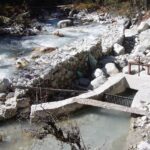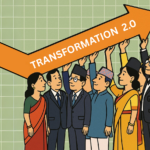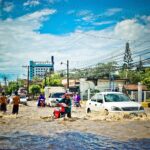Driving along the Nepal-China border through the winding roads of Syabrubesi and Timmure, I was amazed by the number of electric vehicles that are parked on the roadside. These parked cars caught my attention, especially since the open spots in Kyirong, China, were filled with them too. I couldn’t help but wonder about the business model behind this trend: who finances these vehicles, how are parking arranged and paid for? It seems as if the Nepali businesses rely on intuition over data and analysis. While we hear many success stories, the narratives of vehicles deteriorating in parking lots and their impact on banks rarely come to light.
It was sheer coincidence that I came across a post on Facebook by General Sam Cowan, which shared a video of the Kyirong border point from April 25, 2025. In the video, people were scrambling as a massive earthquake wreaked havoc on both sides of the border. The previous year, in September, heavy rains had also created chaos to an area rebuilding after the earthquake. Roads on both sides were washed away. On the Chinese side, the city of Kyirong has been rebuilt in a more organized manner and the highway repairs are progressing rapidly, with reports indicating it will be ready by August. In contrast, on the Nepali side, the condition of highway finds its way into the speeches made by ministers who travel by helicopter, but the reality is far different from what they describe. The journey from Kathmandu to Nuwakot which is 50 kilometers, takes about two hours. However, the 80 kilometers journey from Nuwakot to the border takes nearly four hours! This raises suspicions about whether there is a political motive behind not prioritizing the construction of the road. If the road were to be built as the ministers claim it should be, the containers could travel from Kyirong to Kathmandu in just half-a-day. What would happen to the transport syndicates then? And what would become of the hundreds of bulldozers and equipment deployed daily to work on perennially repairing roads? There are just a few questions that arise when considering the situation.
Local businesses rely on a diverse group of people that are seldom featured in media stories. The practice of commissioning articles and having journalists or stringers conduct onsite reporting is often viewed as outdated since publishers tend to save money using this narrative. During our stay at a lodge in Timmure, the owner expressed her enthusiasm about reopening of visas for Indian tourists wishing to visit Kailash Mansarover. “There are over 30 helicopters landing here pointing at the place that is filled with electric vehicles” she said. Additionally, she mentioned that they are clearing the area. “Most of the people who arrive by helicopters are NRIs,” or Non Resident Indians, who are on pilgrimage. On the Chinese side, we noticed a row of Nepali license plate motorcycles rented by tourists embarking on a bike expedition in The Tibet Autonomous Region. We also met a group led by a Nepali Sherpa who was guiding a team of international climbers preparing to summit Everest from the Chinese side. He explained that climbing from this side costs about USD 20,000 per person more including all expenses. However, it is more organized and convenient as there are no cartels to contend with and the transportation and other facilities are very helpful.
During my time in China, I was captivated by the wide variety of Chinese-made automobiles on the road and in parking lots. From compact electric vehicles used for deliveries to sleek looking SUVs to the large trucks and vehicles, the diversity is impressive. It’s clear that Chinese automobiles are truly competitive in global scale which is evident as you witness it firsthand. Twenty years ago, the automotive landscape was different, and there were fewer options to choose from. Similarly, the way Kyirong town now resembles a city of the future in its development. The brochures at the newly constructed hotel where we stayed featured a map highlighting Jilong as the hub for South Asia, with arrows linking it to major cities like Dhaka, Bangaluru, Delhi and Mumbai. It is being showcased as a city rich in art, culture, business and tourism, portraying its dynamic potential. There is transformation in the narrative and action.
Kyirong is home to many Nepali owned restaurants and shops with a designated Nepali Leisure Street marked on the map. This street is filled with Nepali eateries and shops, with many Nepalis working here. Residents of adjacent Rasuwa district in Nepal are allowed to move freely in Kyirong with day passes, and they can work there with official work permits that must be renewed periodically. Visitors to Kyirong may be surprised to find their ability to communicate in Nepali while getting around. Kyirong holds historical significance as it was the first city where the Tibetan King Songtsen Gampo brought his newly wedded wife, Princess Bhrikuti, in the 7th century from Nepal. The Pakba Monatery, built in Nepali architectural style houses the Goddess Avaloketeshwara whom the princess brought with her. Wedding rituals were performed at the location where Guru Padmasambhava meditated in Gyephuk Village, which is now a popular site for visitors. While there is much discussion about roti-beti (breaking bread and marital relations) between Nepal and India, I keep highlighting in my writings the similar relations existing with our northern neighbor, Tibet.
China is surely in a hurry to push connectivity and growth in the Tibet Autonomous Region or Xizang as they like to popularize. As Nepal has benefited from improved roads and connectivity in India, it will also benefit from this as well. But it will about be getting our act together on the Nepal side. It will be small things that will manner. Questioning why vehicles must stop at eighteen checkpoints from Kathmandu to the border, why the x-ray scanner at the customs office is just locked in a room, why the room at the quarantine center has gaping holes and chickens take seats at the immigration office waiting area. If the folks in government who write on targets of NPR 30 billion revenue (USD 215 million), they need to look at stuff to improve that will not even cost a hundred thousand dollars! Small changes can only lead to large transformations. We are land-linked to two fastest economies in the world, we need to really take advantage of this by thinking long term but starting small.
Sujeev is the founder CEO of beed. He leverages over 25 years of experience in diverse fields and geographies to advise, lead and inspire. With comprehensive networks in Nepal’s public, private, civil and diplomatic sectors, Sujeev is a trusted business and policy advisor and respected strategic thinker. From economies of developing countries to economies of human beings, he moves across different worlds, with his passion for the Himalayas being the axis.





